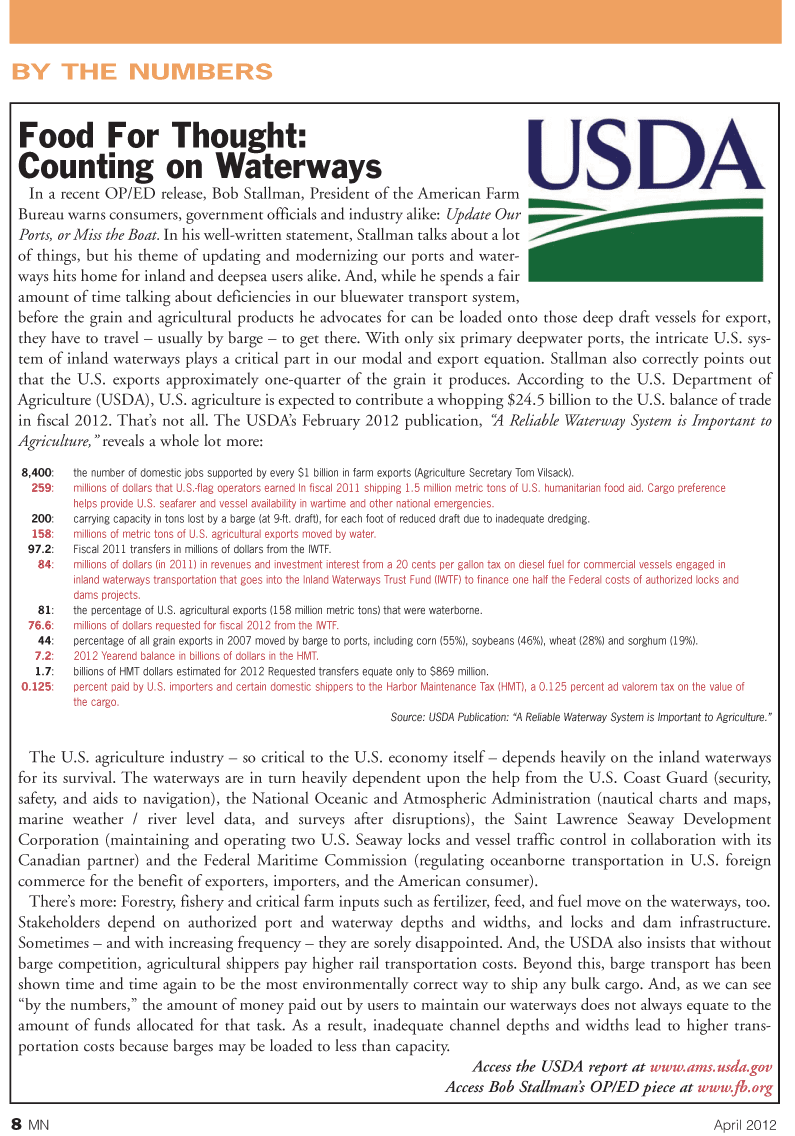
Page 8: of Marine News Magazine (April 2012)
Offshore Service Operators
Read this page in Pdf, Flash or Html5 edition of April 2012 Marine News Magazine
8MNApril 2012BY THE NUMBERS Food For Thought: Counting on Waterways In a recent OP/ED release, Bob Stallman, President of the American Farm Bureau warns consumers, government officials and industry alike: Update Our Ports, or Miss the Boat. In his well-written statement, Stallman talks about a lot of things, but his theme of updating and modernizing our ports and water- ways hits home for inland and deepsea users alike. And, while he spends a fairamount of time talking about deficiencies in our bluewater transport system, before the grain and agricultural products he advocates for can be loaded onto those deep draft vessels for export, they have to travel ? usually by barge ? to get there. With only six primary deepwater ports, the intricate U.S. sys- tem of inland waterways plays a critical part in our modal and export equation. Stallman also correctly points out that the U.S. exports approximately one-quarter of the grain it produces. According to the U.S. Department of Agriculture (USDA), U.S. agriculture is expected to contribute a whopping $24.5 billion to the U.S. balance of trade in fiscal 2012. Thats not all. The USDAs February 2012 publication, A Reliable Waterway System is Important to Agriculture,? reveals a whole lot more: 8,400:the number of domestic jobs supported by every $1 billion in farm exports (Agriculture Secretary Tom Vilsack). 259:millions of dollars that U.S.-flag operators earned In fiscal 2011 shipping 1.5 million metric tons of U.S. humanitarian food aid. Cargo preference helps provide U.S. seafarer and vessel availability in wartime and other national emergencies. 200:carrying capacity in tons lost by a barge (at 9-ft. draft), for each foot of reduced draft due to inadequate dredging. 158:millions of metric tons of U.S. agricultural exports moved by water. 97.2:Fiscal 2011 transfers in millions of dollars from the IWTF. 84:millions of dollars (in 2011) in revenues and investment interest from a 20 cents per gallon tax on diesel fuel for commercial vessels engaged in inland waterways transportation that goes into the Inland Waterways Trust Fund (IWTF) to finance one half the Federal costs of authorized locks and dams projects. 81:the percentage of U.S. agricultural exports (158 million metric tons) that were waterborne. 76.6:millions of dollars requested for fiscal 2012 from the IWTF. 44:percentage of all grain exports in 2007 moved by barge to ports, including corn (55%), soybeans (46%), wheat (28%) and sorghum (19%). 7.2:2012 Yearend balance in billions of dollars in the HMT. 1.7:billions of HMT dollars estimated for 2012 Requested transfers equate only to $869 million. 0.125:percent paid by U.S. importers and certain domestic shippers to the Harbor Maintenance Tax (HMT), a 0.125 percent ad valorem t ax on the value of the cargo. Source: USDA Publication: A Reliable Waterway System is Important to Agriculture.? The U.S. agriculture industry ? so critical to the U.S. economy itself ? depends heavily on the inland waterways for its survival. The waterways are in turn heavily dependent upon the help from the U.S. Coast Guard (security, safety, and aids to navigation), the National Oceanic and Atmospheric Administration (nautical charts and maps, marine weather / river level data, and surveys after disruptions), the Saint Lawrence Seaway Development Corporation (maintaining and operating two U.S. Seaway locks and vessel traffic control in collaboration with its Canadian partner) and the Federal Maritime Commission (regulating oceanborne transportation in U.S. foreign commerce for the benefit of exporters, importers, and the American consumer). Theres more: Forestry, fishery and critical farm inputs such as fertilizer, feed, and fuel move on the waterways, too. Stakeholders depend on authorized port and waterway depths and widths, and locks and dam infrastructure. Sometimes ? and with increasing frequency ? they are sorely disappointed. And, the USDA also insists that without barge competition, agricultural shippers pay higher rail transportation costs. Beyond this, barge transport has been shown time and time again to be the most environmentally correct way to ship any bulk cargo. And, as we can see by the numbers,? the amount of money paid out by users to maintain our waterways does not always equate to the amount of funds allocated for that task. As a result, inadequate channel depths and widths lead to higher trans- portation costs because barges may be loaded to less than capacity. Access the USDA report at www.ams.usda.gov Access Bob Stallmans OP/ED piece at www.fb.org

 7
7

 9
9
